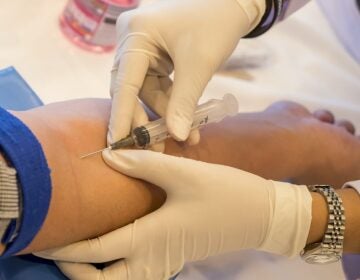Doctors scramble to care for U.S. babies with Zika-related birth defects
Listen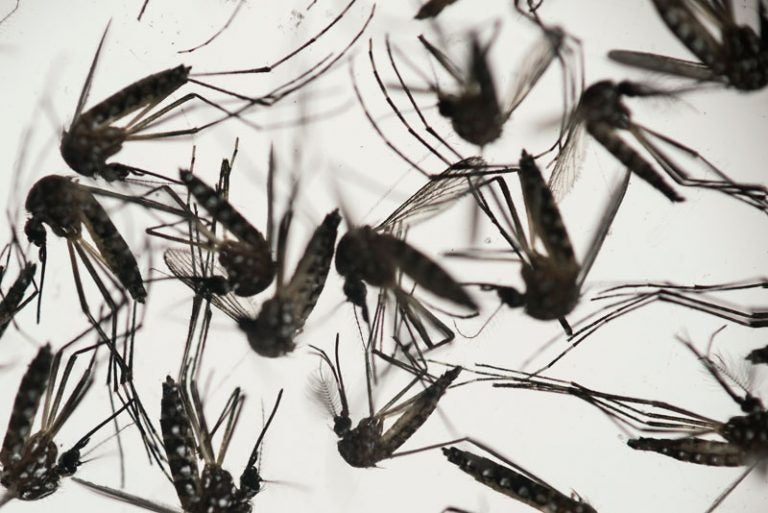
Maria Rios, 20, watches over her baby, Aryanna Guadalupe Sanchez-Rios. (Heidi de Marco/KHN)
When her daughter was born in January, the first thing Maria Rios checked was the baby’s head.
She’d seen the terrifying photos on the internet — infants in Brazil and in Puerto Rico whose skulls were misshapen, even collapsed, ravaged by the Zika virus that has spread across Latin America.
Days earlier, U.S. doctors had told Rios — a 20-year-old, first-time mother — that she was infected with Zika, likely spread by a mosquito bite at her parents’ home in Colima, Mexico, last summer.
Rios, who lives in Lacey, Washington 90-minutes south of Seattle, desperately wanted them to be wrong.
“I saw that the babies had flat heads,” she recalled. “And they had problems eating, seeing, talking, walking. They had seizures. I was just like, ‘Oh, God.'”
When Aryanna Guadalupe Sanchez-Rios arrived — 5 pounds, 10 ounces, with a cap of straight, dark hair — it was clear that something was wrong. The baby’s head was far smaller than normal: 27 centimeters instead of the 35 centimeters it was supposed to be, a condition known as microcephaly. An early ultrasound of her brain showed extensive calcium deposits, more signs of severe Zika damage, doctors said.
Still, Rios refused to lose hope. To her, Aryanna’s head “wasn’t really flat,” just small, she said. Eye exams showed scarring in the center of the retinas, a likely sign of vision loss caused by the virus. But Rios is certain her baby’s wide brown eyes already track light and motion.
“I just want her to be OK,” Rios said.
Despite doctors’ warnings and medical facts, the young mother remains optimistic, relying on a deep Catholic faith to build a life for her daughter. As of May 23, Aryanna was one of 72 babies born in the U.S. states and Washington, D.C., with Zika-related birth defects.
Another eight pregnancy losses are attributed to Zika infections, according to the Centers for Disease Control and Prevention, which updates counts regularly.
Aryanna, who was born in late January, and the other infants are now at the center of efforts by U.S. officials to monitor the lasting effects of the outbreak, even as another dangerous mosquito season begins.
“A lot of people ask for miracles,” said Rios, who keeps a beaded bracelet with an amulet of the Blessed Virgin Mary on her daughter’s left wrist. “I feel like you have to ask deep from your heart.”
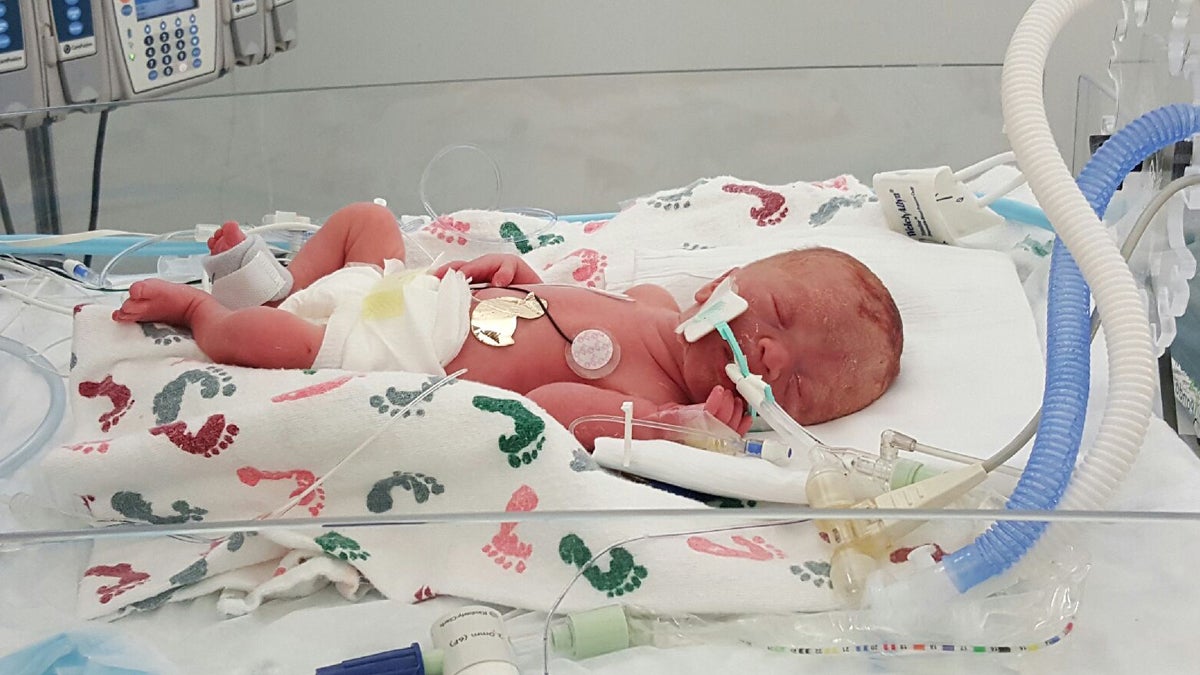
Three-month-old Aryanna Guadalupe Sanchez-Rios rests on her mother’s lap on May 3, 2017. Rios was born with Zika-induced microcephaly, a condition in which the head is smaller than average. (Heidi de Marco/KHN)
To date, Rios is among nearly 1,900 pregnant women in the U.S. states and the District of Columbia with laboratory evidence of possible Zika virus infection, according to the CDC. Nearly 1,600 have completed their pregnancies.
Of those with confirmed Zika infections, 1 in 10 women in at least 44 states have had a baby with brain damage or other serious defects, a recent CDC analysis showed.
Rios was tested twice for Zika and told that she was free of infection. But days before Aryanna was born, a third test came back positive.
“A doctor told me, ‘You have Zika. That’s why your baby has microcephaly,'” Rios recalled. “She could have said it a little bit nicer.”
Aryanna tested positive for the virus, too.
The news was devastating for Rios, a U.S. citizen who had been living with her husband and her parents in Colima, a city on the Pacific coast of Mexico. She returned to the U.S. last fall to stay with family in Washington state.
“I said, ‘How could that be possible?’ I didn’t have any symptoms,” said Rios.
She later learned that 4 of every 5 people infected with the Zika virus show no signs of the disease.
Even now, she finds it hard to believe that anything’s wrong. When Aryanna wakes from a nap, sleepy and warm, Rios swaddles her in a pink polka-dot blanket and cradles her on the couch.
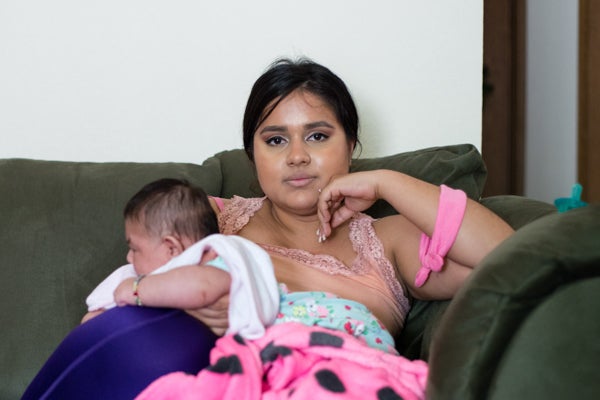
Maria Rios, 20, holds her daughter Aryanna Guadalupe Sanchez-Rios, who was born with microcephaly, on May 3, 2017. Maria, a U.S. citizen, was infected with the mosquito-borne Zika virus while she was living with her husband in Colima, Mexico, last year. (Heidi de Marco/KHN)
“Hi, Stinky! Hi, Pretty Girl!” she croons, kissing Aryanna’s chubby cheek. “I look at her like a normal baby.”
Rios and Aryanna are enrolled in the U.S. Zika Pregnancy Registry, where state and local health departments are tracking women and infants with laboratory evidence of infection.
Even in Washington, a low-risk state where the Aedes aegypti and Aedes albopictus mosquitoes that spread Zika aren’t found, 18 pregnant women have been identified with lab evidence of the virus since last year, said Hanna Oltean, an epidemiologist tracking Washington’s cases. All appear to have acquired the virus through travel, though Zika can be transmitted through sex as well.
Of those local women, three have delivered babies with microcephaly.
“There’s been a definite learning curve in public health,” Oltean said. “This is the first mosquito-borne disease that has been anything like this.”
Hannah Tully, a pediatric neurologist at Seattle Children’s Hospital, examined Aryanna five weeks after birth and again this month. An expert in microcephaly, Tully has seen many children with the disorder, but Zika is different, she said. The damage appears to be greater than that typically found with the disorder, which can be caused by other conditions, including infections and premature birth.
“Zika triggers this catastrophe of inflammation and cell death,” Tully said.
Scientists now know that Zika, a once-obscure virus, targets and attacks neural stem cells in the developing fetal brain. Babies born with congenital Zika syndrome often have severe microcephaly, diminished brain tissue and eye damage, as well as restricted joint movement and rigid muscle tone.
Recent research suggests they also might suffer hearing problems and seizure disorders, such as epilepsy.
“It’s critically important that these babies be evaluated early,” said Margaret Honein, chief of the CDC’s birth defects branch. “We don’t yet know the full range of health problems these babies might have.”
It’s a crucial question, Honein added. Every week, another 30 to 40 cases are added to the pregnancy registry.
The full cost of the epidemic isn’t clear. In September, Congress allocated about $1.1 billion in emergency funding to federal agencies for the Zika crisis. CDC has already spent about $300 million in redirected funds and has designated about $394 million more, according to an agency spokeswoman.
The White House budget released in May proposes that the government establish an emergency fund to better respond to emerging outbreaks like Zika. But it also would cut $1.3 billion from the CDC and $838 million from the National Institute of Allergy and Infectious Diseases, where scientists are working on a vaccine to prevent Zika infection.
None of that funding covers what it may take to raise children like Aryanna.
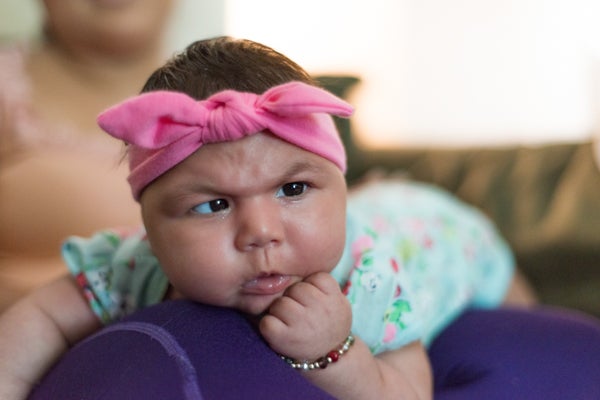
Three-month-old Aryanna Guadalupe Sanchez-Rios. (Heidi de Marco/KHN)
One estimate led by researchers at Yale University and the Johns Hopkins Bloomberg School of Public Health pegs the medical and other expenses for a Zika-affected child at $4.1 million over a lifetime. Previous CDC estimates have been as high as $10 million.
The thought scares Rios, who shares a modest, two-bedroom apartment with her sister and brother-in-law. Aryanna’s condition means Rios can’t return to her former job as a receptionist for a packaging firm, so she relies on family for rent, food, diapers, clothes and transportation.
That help is precarious, too. Rios’ sister has been providing rides to medical appointments in Seattle. But the car broke down in May, forcing Rios to scramble for last-minute transportation.
Rios gets formula from the federal Women, Infants, and Children program, WIC, and Aryanna’s medical care is covered by Medicaid, the state and federal program for poor and disabled people. Rios has applied for Social Security disability benefits, but the process is long and the assistance hasn’t come through.
“Where would I get $4 million?'” she said.
Rios was born in Auburn, Washington, and raised there until age 15, when she moved with her parents to Mexico to help take care of her ailing grandmother. She returned at 18 to finish high school. That’s when she met her husband, Julio Sanchez, 26, who was working in the U.S. as a landscaper on a temporary visa.
The pair dated, fell in love and married in September 2015. They moved to Colima three months later, in December, after his visa expired, just after the first three cases of Zika infection were reported in Mexico.
Rios discovered she was pregnant in April 2016. The news was a surprise; doctors initially thought she had a cyst on an ovary. Sudden bleeding put Rios on bed rest for five months, and she spent that time worried more about miscarriage than mosquito-borne virus.
Even when an ultrasound at six months showed that the baby’s head lagged in development by two weeks, doctors weren’t concerned.
“They said, ‘Oh, don’t worry,'” Rios recalled. “In Colima, I didn’t see anybody alarmed about Zika.”
In February, Mexican health officials reported that Colima is now one of four states in the country with the highest incidence of Zika infections, with 189 cases confirmed in pregnant women from 2015 through March 2.
Rios wanted to give birth in the U.S. to ensure that her daughter would be a citizen and to receive proper care, even though it meant leaving her husband behind. She texts him constantly.
“I just hope he gets some sort of permission to be in the U.S.,” Rios said.
Her husband met Aryanna in April, when Rios traveled with the baby back to Colima.
“He didn’t even know what Zika was,” Rios recalled. “I said, ‘Look it up.'”
Rios’ parents, both in their early 40s, didn’t hide their concern for their daughter and their first grandchild.
When Rios and Aryanna arrived, the family drove straight from the airport to a church in Talpa de Allende, where Rios’ father walked on his knees from the back to the altar, a hopeful gesture to keep Aryanna safe from harm.
“My mom just keeps telling me, ‘Everything’s going to be fine,'” Rios said.
Sometimes, Rios is not so sure. Her days revolve around Aryanna, who receives weekly visits from a public health nurse and a physical therapist and has doctors’ appointments lined up six months in advance.

Pediatrician Timothy Brei examines Aryanna Guadalupe Sanchez-Rios during her checkup on May 5, 2017. (Heidi de Marco/KHN)
The baby endured a nine-hour round of medical tests on a recent Friday, including neurological and eye exams and an MRI. Aryanna was patient while a technician measured her head — 33.2 centimeters. At 3 months, it was still smaller than a typical newborn measurement of 35 centimeters.
But the baby screamed in outrage as Michelle Trager Cabrera, a pediatric ophthalmologist, shined a bright light and peered deeply into her dark eyes.
“There’s a chance her vision could be quite impaired,” concluded Cabrera, who saw scarring on the baby’s retinas.
“I just want to know if she could wear glasses?” Rios asked.
“This is a relatively new problem that we don’t understand well,” Cabrera said, adding gently: “I don’t think glasses are going to help.”
That news worried Rios. So did the results of the MRI, which confirmed Aryanna had brain damage from the effects of the Zika infection, Rios said.
At the hospital, Rios asked her sister to watch the baby for a minute and stepped outside into a hospital atrium. She sat down at a table, placed her head in her hands and started to cry.
“I try to be strong for her,” Rios said, between sobs. “I’m really scared. It’s hard.”
The worst thing about Zika, she said, is that no one, not even the doctors, can tell her what’s next.
“I still have my hope,” she said. “I’m trying everything for my girl to be OK.”
This story was produced in collaboration with Kaiser Health News, a national health policy news service.
WHYY is your source for fact-based, in-depth journalism and information. As a nonprofit organization, we rely on financial support from readers like you. Please give today.




